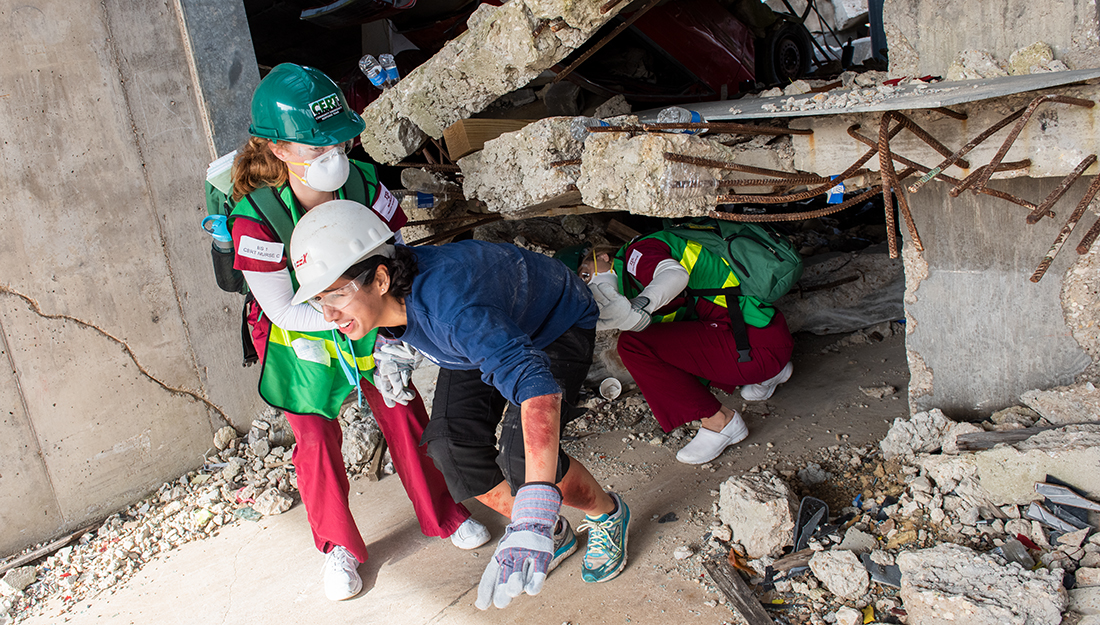- Mary Leigh Meyer
- Medicine, Nursing, Pharmacy, Public Health, Show on VR homepage, Trending
Texas A&M simulates disaster to train students in emergency response
The largest student-led interprofessional emergency response simulation in the country, hosted by the Health Science Center

The Texas A&M University Health Science Center conducted Disaster Day, the largest student-led interprofessional emergency response simulation in the country today. Started by the Texas A&M College of Nursing and now in its 11th year, the event is designed to give future health care and public health professionals experience working together in a disaster scenario.
The one-day event, which is carefully planned and executed by Texas A&M Health Science Center students, with oversight from a faculty and staff steering committee, provides students with critical life-saving skills required in disaster situations. Not only are participants better prepared to respond in real-life emergencies, but they also learn vital skills to practice collaboratively. The event is held at Texas A&M Engineering Extension Service’s (TEEX) Brayton Fire Training Field and Disaster City, a 52-acre mock city that serves as a training facility for our nation’s emergency responders.
A new scenario is selected each year and kept secret until event day to provide the realism of an unexpected situation. Last year’s event was a train crash, and this year’s event simulated a chemical explosion and building collapse where nearly 600 students from the Texas A&M College of Medicine, College of Nursing, Irma Lerma Rangel College of Pharmacy, School of Public Health and the College of Veterinary Medicine & Biomedical Sciences engaged in triage at the disaster site, patient care at a mock field hospital and disaster management and simulation oversight at Disaster City’s Emergency Operations Training Center.
The students had to react to mass “injuries,” with volunteers in makeup portraying victims with various degrees of wounds, from cuts to compound fractures. The volunteers mimicked panicked patients as they screamed, cried and pleaded for help. At the end of each exercise, instructors and other observers critiqued student teams on their strategy and communication to help improve their skills for a real-life disaster.
“Disaster Day is one of the most transformational interprofessional education exercises at Texas A&M, where students from the Health Science Center and College of Veterinary Medicine and Biomedical Sciences—and for the first time this year, the Corps of Cadets—come together for effective management of an emergency situation,” said Carrie L. Byington ’85, MD, vice chancellor for health services at The Texas A&M University System, senior vice president of the Health Science Center and dean of the College of Medicine. “We are grateful to our system partner TEEX for providing this premier facility for our students to learn in a realistic, hands-on environment, where emergency response professionals from across the nation regularly train.”
During the simulation, students either act as providers or emergency management officials. As each team is interprofessional, students can gain a greater perspective on how different health professions collaborate. In collaboration with all of the people and groups required to make an event of this scale happen, the Health Science Center’s Office of Interprofessional Education & Research leads the committee that guides the production of Disaster Day, as its function is to promote and support collaboration across health disciplines.
“Although part of our students’ education occurs in the same room and the same simulated experience as students in other professions, what we really want to do is change the way our graduates think about team medicine and how they approach and embrace the concept of the team approach,” said Regina Bentley, EdD, MSN, RN, CNE, assistant vice chancellor for health services at The Texas A&M University System and clinical associate professor at the College of Nursing.
“When health sciences students train along side each other, they directly see the value that each discipline is bringing to the table,” added Christine Kaunas, MPH, executive director of interprofessional education and research. “We see that team-based, emergency response training provides for better and safer health outcomes.”
These students act as first responders during emergency situations across the country after they graduate, which makes the training provided by Disaster Day irreplaceable.
“Training for emergency situations is imperative,” said Corey Authement, College of Nursing student and training director for this year’s Disaster Day. “When you have multiple groups responding to an incident, the interprofessional aspect really comes into play. This interprofessional training is important to be able to respond appropriately in the future.”
Nicole Mancuso, a graduate of the College of Nursing, can attest to this. She was working in a Las Vegas emergency room during the mass shooting on the Las Vegas strip in October 2017. “It was probably the worst thing I have ever seen in my life, and I hope I never have to see it again,” Mancuso said. She credits her training at the college and involvement in Disaster Day for teaching her how to appropriately triage and treat patients in mass casualty scenarios. “Having the knowledge of triaging really helped to know who needs more time from me and who is okay in comparison. What I learned at the college built my initial skills to become an emergency room nurse.”
This year, emergency response professionals from both Germany and England traveled to observe the scenario and gain insight into how they could bring some of the concepts back to their countries. Members of the Texas State Guard also participated, training members of the Texas A&M Corps of Cadets in extraction procedures for the “injured.”
H-E-B’s director of emergency preparedness, Justen Noakes, led a team from their headquarters in San Antonio. His staff served breakfast and lunch to simulation participants from their mobile cooking facility, one of the several H-E-B deploys during real disasters such as Hurricane Harvey.
“Disaster Day is a unique opportunity for students to gain firsthand experience in emergency response, conducting duties that are usually entrusted to health care and emergency officials,” Kaunas added. “With interprofessional collaboration, hundreds of students understand how they can conduct disaster response when lives are at stake while building critical thinking and teamwork abilities.”
“Often health care providers compartamentalize themselves—they identify as nurses, as physicians as pharmacists as public health professionals—and do not communicate with each other,” added Charles Borrego, College of Nursing student and incident commander of this year’s Disaster Day. “So starting an interprofessional education early in the learning process helps to break down the compartments and open lines of communication.”
Creating an event of this magnitude necessitates a great amount of support. Generous sponsors for the one-day mock disaster included the colleges of medicine, nursing, pharmacy and public health, the Association of Former Students and H-E-B.
“I am so proud of all the students, faculty and staff who plan and execute these extraordinary scenarios each year with the goal of providing transformational education to our health students,” Texas A&M University President Michael K. Young said. “It is experiences like this that ensure our graduates who go on to careers in the health field are well prepared for its many challenges and rewards.”
Media contact: media@tamu.edu


